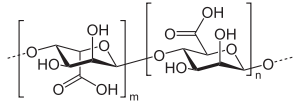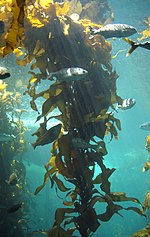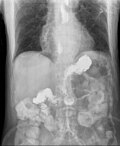Alginic acid, also called algin, is a naturally occurring, edible polysaccharide found in brown algae. It is hydrophilic and forms a viscous gum when hydrated...
21 KB (2,232 words) - 10:08, 12 October 2024
algae, and is not found in land plants. Alginic acid can also be used in aquaculture. For example, alginic acid enhances the immune system of rainbow trout...
59 KB (5,893 words) - 16:27, 11 October 2024
"Alginate" is usually the salts of alginic acid, but it can also refer to derivatives of alginic acid and alginic acid itself; in some publications the...
6 KB (715 words) - 18:03, 11 September 2024
acid is a uronic acid monosaccharide that can be derived from mannose. Along with l-guluronic acid, d-mannuronic acid is a component of alginic acid,...
3 KB (130 words) - 13:13, 15 September 2023
d-mannuronic acid. Along with d-mannuronic acid, l-guluronic acid is a component of alginic acid, a polysaccharide found in brown algae. α-L-Guluronic acid has...
3 KB (210 words) - 13:05, 9 September 2024
Gastroesophageal reflux disease (redirect from Acid reflux)
inhibitors, H2 receptor blockers and antacids with or without alginic acid. The use of acid suppression therapy is a common response to GERD symptoms and...
60 KB (6,188 words) - 17:22, 15 November 2024
E number E405. Chemically, propylene glycol alginate is an ester of alginic acid, which is derived from kelp. Some of the carboxyl groups are esterified...
2 KB (90 words) - 13:12, 29 September 2021
combat oesophageal reflux. Commonly, following ingestion a 'raft' of alginic acid is created, floating on the stomach contents by carbon dioxide released...
2 KB (184 words) - 19:41, 8 November 2023
starches, pectins and agar-agar or proteins such as gelatin. Examples are: Alginic acid (E400), sodium alginate (E401), potassium alginate (E402), ammonium alginate...
19 KB (2,376 words) - 10:59, 29 September 2024








